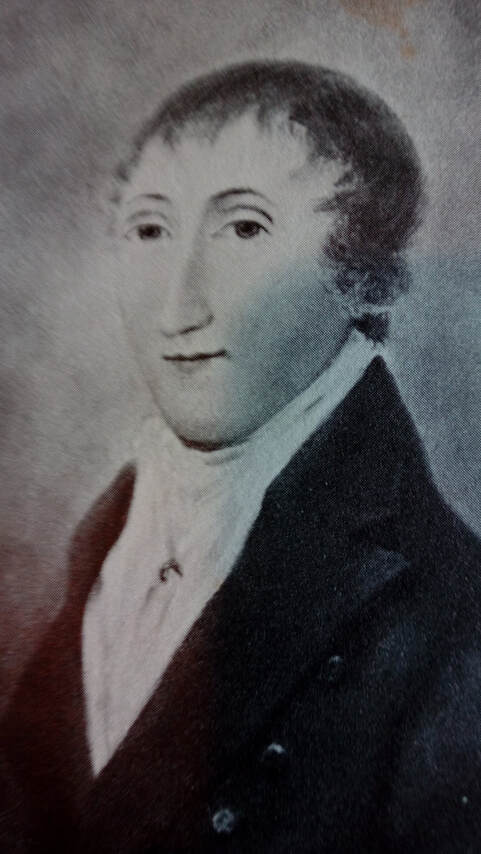|
By Barry Lally “To drink a toast,
A proctor roast, Or bailiff as the case is, To kiss your wife Or take your life At ten or twenty paces, To keep game-cocks, To hunt the fox, To drink in punch the Solway, With debts galore, But fun far more; Oh, that’s the man for Galway.” Reputed to be the original of the protagonist in one of Charles Lever’s novels of rollicking adventures in the early 19th-century Irish countryside, Giles Eyre was born in Eyrecourt on 19th July 1764. According to family tradition, the first Eyres arrived in England with William the Conqueror. In the course of time, they divided into two branches, one in Derbyshire and the other in Wiltshire, the former remaining Catholic at the Reformation, while the latter conformed to the Church of England. Two of the younger sons of the Wiltshire Eyres, John and Edmund, accompanied Cromwellian General Ludlow to Ireland in 1651. Edmund established himself in Galway town, eventually becoming mayor and giving his name to the city square. His brother amassed large estates in East Galway, as well as other lands in Tipperary, Clare and King’s County. At first, John lived in the village of Clonfert before moving into Ballymore Castle near Eyrecourt, which had been confiscated from the Lawrences. Eyrecourt Castle was built in 1661 on lands purchased from Sir Thomas Esmonde and featured a magnificently carved double staircase imported from Holland and occupying a third of the entire building. John founded Eyrecourt village, which became a thriving location of the linen industry in the 18th century. The Eyres were renowned for generosity, simple dealing and attachment to the countryside, earning a reputation as kind and considerate landlords whose estate in consequence was never subjected to agrarian outrages. In matters of religion they were tolerant and quite averse to proselytizing, which probably explains why in 1700 they were instrumental in having a small group of Quaker preachers arrested in Eyrecourt and put in the village stocks before their eventual release. Another John Eyre, a descendant of the original, was ennobled in 1768 as Baron Eyre. He was said to have lived “according to the style of the country, with more hospitality than elegance, for while his table groaned with abundance, the order and good taste of his arrangements were little thought of.” In 1775 his only child, Mary, who had married Lord Charlemont, was drowned together with her husband and their young infant when their ship sank in a hurricane between England and Ireland. A philistine who kept no books in his house, the Baron devoted his time to drinking claret and watching cock-fights. When he died in 1781 he was succeeded by his brother Richard, Giles’s father. That same year the family was obliged because of debts to vacate the Castle and lease it to Michael Prendergast for close on a quarter century. Giles’s education had been so sadly neglected that he grew to adulthood unable to read or write. He seems to have inherited all his uncle’s vices and a few more besides. A contemporary described him as “a great sportsman, a negligent farmer, and a most careless father: he looked upon a fox as an infinitely more precious part of creation than a French governess, and thought that riding well to hounds was a far better gift that all the learning of a parson.” In 1792 he married Anne Daly, a cousin of the Trenches of Garbally, with whom he had two sons and four daughters. Six years later he was appointed a Colonel of the Galway Militia and High Sheriff of the county. He married secondly Sophia Walsh of Tipperary in 1806. His illiteracy notwithstanding, he entertained political aspirations, and in 1811 he stood for Parliament in the Galway constituency. Despite, however, his incurring electoral expenses amounting to £80,000, the equivalent of several millions of euros in today’s money, the voters of the county decided that as far as they were concerned Giles was not “the man for Galway” when they chose Richard Martin of Ballynahinch as their representative in his stead. To avoid process-servers, Giles would barricade himself at the top of his house, drawing up his food by means of a rope attached to a basket. Another eccentricity of his was, when “flush”, to leave a plate of money outside his front door from which passing beggars could help themselves. If keeping 30 to 40 hunters, as well as three packs of hounds, was a qualification to be Master of the County Galway Hunt, then Giles certainly met that criterion, occupying the position from 1791 to 1829, the year before his death. It was during his term in office that the Hunt became known as the Blazers. Legend has it that their new title was acquired following an incident at Dooley’s Hotel in Birr. Giles and his companions had been entertaining members of the Ormond Hunt when, having dined “not wisely but too well”, they set fire to the premises before their departure. John Eyre, Giles’s eldest son, apparently continued the family tradition of financial irresponsibility, spending several years in debtors’ prisons. The estate had to be put up for sale in 1854 with encumbrances of over £40,000. Some of the lots sold were bought in for the family, enabling them to remain in residence at Eyrecourt. John, aged 61, was killed in a fall from his horse while hunting near Kiltormer in 1856. William Henry Gregory, the last of the Eyres to reside at Eyrecourt, died in a Dublin nursing home in 1925. By now the estate had dwindled from over 30,000 acres in its heyday to 620 acres. The following year the beautiful Dutch staircase was purchased by Sir Charles Allom, a London interior decorator, who had it dismantled and shipped to California to be installed at San Simeon, one of the palatial residences of William Randolph Hearst, the newspaper magnate. For some reason the plan was never carried through, and when Hearst died in 1951 the staircase was donated to Detroit Institute of the Arts where it remains to this day in its original packing cases. I leave the last word to a commentator on the fate of the landed class in Ireland, which applies especially to the Eyres: “Profligate spending, too much enthusiasm for horses, dogs, card games and alcohol, all made the political ramifications of land acts and encumbered estate courts merely the finger that pushed this way of life into extinction.”
0 Comments
Leave a Reply. |
CLICK HERE to read the Latest Ballinasloe News Articles
June 2024
|
The Town Team was set up by BACD Ltd. to revive the fortunes of Ballinasloe and its hinterland. With the main focus to build on the town’s many strengths, change existing negative perceptions and bring about measurable improvements in the town centre economy and its wider social value.
|
Ballinasloe Area Community Development Ltd.
Ballinasloe Enterprise Centre Creagh Ballinasloe Co. Galway |
All generic photos and images have been sourced and are free of copyright or are clip art images free of copyright. Photos of Ballinasloe have been donated by BEC. If you have any photos that you would like included on the website please email us
Copyright © All rights reserved, 2024 BACD


 RSS Feed
RSS Feed
